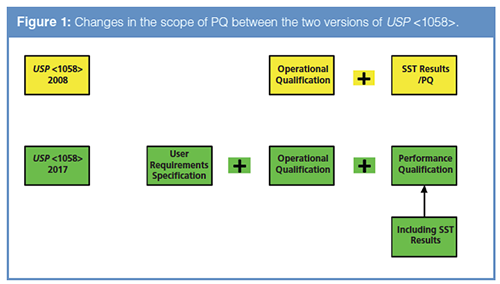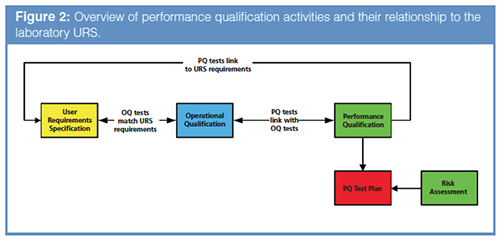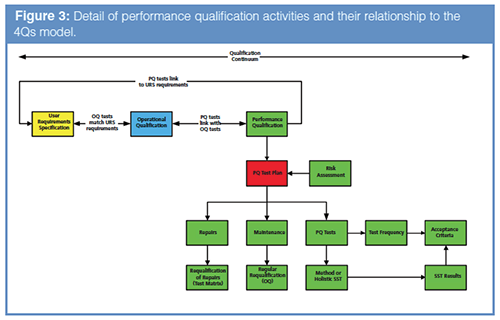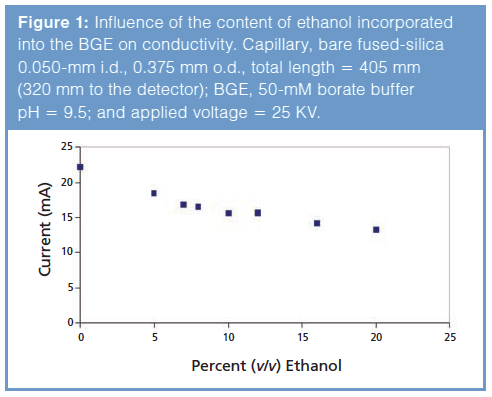Data Integrity and USP : Part 3: Monitoring and Requalification
LCGC Europe
This is the final part of a trilogy looking at the impact of the new USP on analytical instrument qualification (AIQ) on data integrity in a regulated chromatography laboratory. This part will focus on the performance qualification (PQ) portion of the 4Qs model and, specifically, monitoring and requalification of chromatographs.
This is the final part of a trilogy looking at the impact of the new USP <1058> on analytical instrument qualification (AIQ) on data integrity in a regulated chromatography laboratory. This part will focus on the performance qualification (PQ) portion of the 4Qs model and, specifically, monitoring and requalification of chromatographs.
This is the third and final part of a series exploring the impact of the new USP <1058> (1) for analytical instrument qualification (AIQ) on data integrity. In the first part we introduced a data integrity model to show that AIQ was an essential part of data integrity and how users must define their instrument and software requirements to select and purchase the right instrument for the job (2). In the second part we looked at the relationship between the user requirements specification (URS) and the operational qualification (OQ) protocol and how users and suppliers should interact (3).
In this instalment, we consider performance qualification (PQ), monitoring, and requalification. Perhaps we should, with apologies to Star Trek, have titled this column “PQ-The Final Frontier” because this is the least understood portion of the 4Qs model.
The Qualification Continuum
It is worth a quick recap from Part 2 (3) where we discussed the qualification continuum. The new USP <1058> requires that both OQ and PQ tests are linked to the operating parameters of the instrument that are defined in the URS (1). Therefore, when defining PQ tests and plans the relationship between these tests and URS requirements must be foremost in your mind. For background information on PQ and how it relates to the laboratory URS and OQ, please see figure 2 in Part 2 of this series (3).
It is also important to understand the difference between the two versions of USP <1058> regarding performance qualification as shown in Figure 1. With the original version of USP <1058> (4), PQ was widely interpreted as on-going monitoring that can be achieved by system suitability test (SST) results. This column featured such a discussion in 2011 (5). However, the focus has changed with the new version (1) where there are links to both the OQ and the laboratory URS (Figure 1). Here, SST results are a part of PQ but not the complete package.

When the role of SSTs was historically evaluated from a life cycle risk assessment perspective (6), the conclusions were that chromatography-based SSTs needed to be supplemented to detect many instrument faults. Consideration of potential auditor interpretation of the new <1058> against the argument that SST is a PQ now means that this is a higher risk than with the 2008 version.
What Does USP <1058> Say About Performance Qualification?
Having set the scene, what does the new USP <1058> (1) say about PQ? The definition is:
PQ is the documented collection of activities necessary to demonstrate that an instrument consistently performs according to the specifications defined by the user and is appropriate for the intended use.
The PQ verifies the fitness for purpose of the instrument under actual conditions of use.
After IQ and OQ have been performed, the instrument’s continued suitability for its intended use is demonstrated through continued PQ.
This definition is not the same as the 2008 USP <1058> PQ definition (4) because there is now alignment of the PQ with the laboratory requirements documented in the instrument URS. The key element is the phrase “continued suitability for its intended use”. As intended use is defined by the user requirements specification, you can see how important the URS is now because it impacts all qualification activities from design qualification (DQ) through OQ to PQ. Please read Part 1 of our series to understand why (2).
What Actually is PQ?
From the definition above, the documented collection of activities is not very illuminating or self-explanatory, apart from an apparent pile of paper and electronic records. The fundamental question many laboratories have for chromatography instruments and the new <1058> is this: “Are SSTs alone sufficient for a PQ?” The answer is in the next paragraph of USP <1058> (1):
The user must define the PQ plans, including test procedures, acceptance criteria, and frequency.
Preventive maintenance plans and documentation of repairs and other changes are also a necessary part of the overall instrument qualification (1).
Therefore, under the new version of USP <1058> (1), PQ now consists of the following activities, shown in overview in Figure 2, along with the relationship between PQ and the laboratory URS.

The scope of PQ in the new version of USP <1058> is considerably wider than the old version as illustrated in Figure 3 and outlined below:
- PQ test plan outlining what will be done, including the link back to the URS requirements;
- PQ test procedures with acceptance criteria and how often each PQ test will be performed;
- Preventative maintenance (PM), typically followed by a full or partial requalification (OQ) of the instrument as shown in Figure 3;
- Repairs that are followed by appropriate requalification test(s). This is ideally documented in a riskâbased requalification matrix.
Owing to the extent of these changes, it is unlikely that any laboratory’s procedures match the new USP <1058> requirements. It also reinforces the importance of a meaningful laboratory URS that is not a carbon copy of the supplier’s specification, which cannot be overstated (2).

The clarification and extension of PQ requirements in 2017 <1058> mean that PQ is not a single activity, but an integration of planned tests (with frequency and acceptance criteria predefined), maintenance activities, repairs (with partial or full requalification), and checks in operational use, as documented in the instrument logs. Reliance on only SST results is a weak implementation of PQ for chromatography systems. If your laboratory defines PQ as SST results, and an auditor or inspector challenges this interpretation, what would you do?
In the remainder of this column we will focus on PQ test plans, tests, and requalification activities rather than preventative maintenance for chromatography instruments.
Performance Qualification FAQs
Before we get into the details, we have listed a few of the frequently asked questions we have been asked since the new version of USP <1058>:
- Do I need to perform both OQ and PQ for my analytical instruments? You must document how your AIQ satisfies OQ and PQ requirements of the new USP <1058>. Because OQ and PQ test different attributes of the instrument performance, both are required. Details of specific OQ and PQ requirements are dependent on the analytical technology and complexity of the instrument, and the relationship between how the instrument is tested and the conditions of use.
- What’s the difference between an OQ and a PQ? OQ and PQ requirements are defined within USP <1058>, but to simplify: OQ verifies the instrument, satisfies user requirements and range of use, PQ demonstrates that the instrument continues to work under conditions of use.
- I won’t bother with OQ-we’ll just have PQ-is this OK? We will not bother replying to this question!
PQ Test Plans
The heart of performance qualification is the PQ test plan (Figure 3). This does not need to be a lengthy document, the equivalent of War and Peace, but it needs to be scientifically sound and risk-based. It will contain the following:
- Requirements for maintenance both performed in-house but also by the supplier or third-party agent. This is especially important for preventative maintenance that will require an agreement between the laboratory and the service provider defining the scope of work and the responsibilities of both parties.
- In-house repairs and associated requalification activities.
- Both repairs and maintenance must be linked to a requalification matrix that is risk-based. For example, if the pump seals are replaced on the pump, only the flow rates (with a column attached) should be tested because the repair does not impact the rest of the chromatograph. If the pump controls gradient formation should the gradient forming capability be checked as well? The justification for not doing this should be scientifically sound and documented. All tests should be linked back to the laboratory URS to show continued intended use of each module or the whole instrument.
- In addition, the test plan should also include the PQ tests to be carried out on the instruments, including the frequency and acceptance criteria. Chromatographs not meeting the criteria should be taken out of service according to 21 CFR 211.160(b) (7) until the reason for failure is identified and resolved. The nature of the PQ tests will be covered in the next sections.
Additionally, you should not write a PQ test plan for each chromatograph but take a systems-based approach. Write a single document covering all liquid chromatographs in the laboratory or potentially across an organization. The PQ test plan could accommodate variations in the configuration between chromatographs, for example, isocratic versus gradient pumps or UV versus fluorescence detectors.
Direct versus Indirect Assessment of Instrument Performance
Here we have both good and bad news. The good news for some analytical instruments is that it is relatively easy to perform PQ assessment of instrument performance and link it directly to the intended use requirements in the URS. For example, analytical balances can use calibrated reference masses, pH meters can use calibrated reference solutions, and spectrometers can use standards to check wavelength accuracy and photometric linearity. These are all measurements that can be related directly to the instrument requirements that are documented in the URS and that are relatively easy to perform. Typically, these direct tests are metrological.
The bad news is that this is not the case for chromatographs; PQ measurements are either indirect or derived assessment of instrument performance versus user requirements or the repeat of a specific OQ test, for example, flow rate with a calibrated digital flow meter. To be successful any PQ test relies upon a metrological test performed in the OQ to ensure scientifically sound conclusions to be drawn from the indirect tests.
PQ Test Options
The options for PQ testing are shown in Figure 4. The first option on the left is just to use SSTs, the second option is to combine the use of a holistic PQ test applicable to all high performance liquid chromatography (HPLC) instruments of the same type (for example, the same PQ test can be applied to all chromatographs using isocratic elution with UV detection) with method specific SSTs. The final option is to have a PQ specific for each instrument. Scientifically, this last option might be considered for instruments dedicated to a specific method, where the performance of the instrument is challenged by the method requirements, for example, trace impurities analysis.

The earliest regulatory publication on analytical instrument qualification is the 1994 paper by Furman et al. (8) from FDA, which includes a discussion of modular versus holistic qualification of chromatographic instruments. The argument was that if the performance of each module or component was within acceptance limits, in principle, the system could potentially fail as a result of the system components not working correctly together. The authors therefore proposed the inclusion of an overall system, or “holistic test”, in the qualification of chromatography instruments because module testing alone would not detect this.
A holistic PQ test executed after an OQ, or even as part of the OQ, would provide a link between the functional- and metrology-based OQ and the method-based PQ (Figure 4). Some considerations for PQ testing are:
- Move to usage-based maintenance as part of instrument monitoring. The more you use a chromatograph, the more frequently it should be maintained is an option, although most laboratories link preventative maintenance with an annual OQ. Therefore, for a high-use instrument should there be a more frequent maintenance and qualification cycle?
- SST and other monitoring means. How robust is your method? Have you defined the design space and know the influence of key parameters of the procedure, for example, take a life cycle approach to procedures as outlined in the
- draft USP <1220> (9) and to be included in the redrafting of ICH Q2(R2) (10)? Does your poor analytical procedure contribute to out of specification (OOS) results? Note that SST results failing acceptance criteria are a potential data integrity issue that will be subject to rigorous regulatory scrutiny.
- What are the triggers for performing requalification work? See the next section of this column.
- As found calibration before PM-if you can demonstrate the chromatograph meets intended use requirements before PM no problems!
- Prevention and monitoring are better and cheaper than investigation.
Triggers for Requalification
In the expanded PQ definition of the new <1058> (1), after implementation, maintaining the qualification status of the instrument falls under the PQ phase of the AIQ life cycle, stating:
The relevant OQ and PQ test(s) should be repeated after the needed maintenance or repair to ensure that the instrument remains qualified.
The implications of this need to be carefully understood. Because OQ and PQ test different aspects of instrument performance, both stages are required to maintain the instrument qualification status. Once an instrument has been put into routine use, for cause qualification testing of the instrument is required after:
- Change
- Repair
- Maintenance.
Where reduced qualification testing can be justified, then full qualification testing is not required. For changes to the instrument or repairs, in principle, only the instrument functions affected by the change or repair need to be tested. This has implications for both OQ and PQ testing and should be defined in the PQ test plan.
For OQ testing, where there is an approved requalification matrix in the PQ test plan, then the appropriate requalification tests can be performed following repairs to different parts of the instrument. Some companies may classify instrument changes and repairs into major and minor and this is usually tied into a reduced qualification activity; for example, for minor changes or repairs only test the instrument functions affected by the repair, but for major changes or repairs, perform the full suite of qualification testing. The extent of requalification is determined by a risk assessment (Figure 3).
It is therefore advantageous to associate the appropriate tests to be performed following repairs, for example, for replacement of pump seals or check valves on a pump,
the flow rate could be measured using those parameters used in the OQ and provide a direct link back to the URS.
If a requalification matrix or procedure does not exist then a full requalification of the chromatograph is required as there is no defence to audit or inspection questions.
As well as instrument qualification performed “for cause”, in principle, qualification tests could also be triggered by investigations into instrument performance, such as OOS or out of tolerance (OOT) investigations. Such activity would need to be very carefully defined
in the OOS procedure of the laboratory.
Instrument Use Outside of Qualification Limits
If you have an HPLC system where the pump is qualified over the range 1.0 mL/min and 2.0 mL/min and you are asked to establish an analytical procedure with a flow rate of 0.5 mL/min, what should you do? It should be obvious that the pump is operating outside of its qualified range and therefore there is an unknown impact on the method and the data produced. You have one of three choices:
- Modify the method;
- Extend the pump qualification;
- Ignore the issue (this is the second OQ-Ostrich Qualification).
The use of a chromatograph outside qualification limits is a potential step into the unknown and can have an impact on data integrity as well as the ability to transfer analytical procedures between laboratories. Extending the qualification and updating the URS are the only options.
Summary
In this three-part series examining the new USP <1058> and data integrity we have looked at:
- How analytical instrument qualification is a critical component of data integrity because it sits above the data governance foundation in a data integrity model and below the method validation and analysis levels (11).
- The role of a laboratory URS is the baseline for all qualification work. For commercial instruments the URS is expected to be minimal, but suppliers should produce meaningful specifications.
- Don’t copy the supplier’s specification for your user requirements.
- Use acceptance criteria from the pharmacopoeias rather than make your specification tighter.
- The OQ protocol must test the ranges of operation defined in the URS.
- It is acceptable to merge IQ and OQ protocols, but the document must be reviewed and approved prior to execution and post execution.
- All data and records (paper and electronic) generated by the laboratory during qualification work must be retained by the laboratory.
- PQ is not just running SST tests, rather PQ needs a test plan with an overall approach for ensuring that the laboratory can demonstrate that any instrument can meet its intended use requirements defined in the URS.
Although USP <1058> has just been updated, this general chapter will be revised again to align with the life cycle approach outlined in the draft USP <1220> (12).
References
- General Chapter <1058> “Analytical Instrument Qualification” in United States Pharmacopeia 41 (United States Pharmacopeial Convention, Rockville, Maryland, USA, 2018).
- P.A. Smith and R.D. McDowall, LCGC Europe 31(7), 385–389 (2018).
- P.A. Smith and R.D. McDowall, LCGC Europe 31(9), 504–511 (2018).
- General Chapter <1058> “Analytical Instrument Qualification” in United States Pharmacopeia 31 (United States Pharmacopeial Convention, Rockville, Maryland, USA, 2008).
- H. Wätzig et al., LCGC Europe24(8), 418–422 (2011).
- P. Smith and R.D. McDowall, LCGC Europe28(2), 110–117 (2015).
- 21 CFR 211, Current Good Manufacturing Practice for Finished Pharmaceutical Products (Food and Drug Administration: Silver Spring, Maryland, USA, 2008).
- W.B. Furman, T.P. Layloff, and R. Tetzlaff, JOAC International77, 1314–1317 (1994).
- G.P. Martin et al., Pharmacopoeial Forum43(1) (2017).
- Concept Paper: Analytical Procedure Development and Revision of ICH Q2(R1) Analytical Validation (International Council on Harmonization, Geneva, Switzerland, 2018).
- R.D. McDowall, Data Integrity and Data Governance: Practical Implementation in Regulated Laboratories (Royal Society of Chemistry, Cambridge, UK, 2018).
- C. Burgess and J. Hammond, Spectroscopy Europe (2017).
Paul Smith is a Global Strategic Compliance Specialist at Agilent Technologies. After initially specializing in spectroscopy and application of chemometrics to spectroscopic data, Paul developed his compliance expertise in a variety of quality and management roles within the 17 years he spent in the pharmaceutical industry. Paul worked as an independent consultant and university lecturer before moving into laboratory compliance consultancy roles.
“Questions of Quality” editor Bob McDowall is Director at R.D. McDowall Ltd., Bromley, Kent, UK. He is also a member of LCGC Europe’s editorial advisory board. Direct correspondence about this column to the editorâinâchief, Alasdair Matheson, at alasdair.matheson@ubm.com

What Goes in a CDS IT Service Level Agreement?
Published: April 7th 2025 | Updated: April 7th 2025Protecting your network chromatography data system (CDS) data is critical and a service level agreement (SLA) with your IT provider is vital. What should be included? Are SLAs for in-house IT and SaaS (software as a service) similar?








